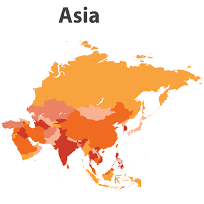Zeus Capital Healthcare Research Director Dr Gary Waanders caught up with DirectorsTalk for an exclusive interview to discuss live biotherapeutics, what’s driving the interest in this field, the key themes for how the LBP’s will work and the companies to look out for including 4D Pharma PLC (LON:DDDD)
Q1: Gary, you’ve published a thematic piece of research today covering the gut microbiome and some of the companies that work in that space. What’s driven the interest in this field?
A1: There are a number of things which have driven that interest but let me focus on 3 areas, if I may; technology, research funding and interest in the global industry.
So firstly, the technology developments. The microbiome, just for background, is made up of over one hundred trillion microbes, most of which live in our intestines, pretty much all animal and plant life on earth will have evolved over millions of years, in a world full of microbes, so it’s probably no surprise that our biology is made up of both our own cells and microbial communities that live in and on us. These perform actually fairly critical functions in respect of our health and in certain cases in disease development, in fact there’s an example where animals born into artificial germ-free laboratory environments do not develop properly functioning intestines, immune system, brain and central nervous system, respiratory tract etc. so they play quite an important role. If you think of a hundred trillion bacteria, made up of several thousand different species, is a system which must prove pretty difficult to unpick because simply trying to cultivate these bugs, and most of them are very fussy, they don’t like oxygen for example, so trying to cultivate those bugs would only let you get to about 10% of the diversity. So, the technology developments that have come about recently, molecular techniques such like massive scale DNA sequencing and others, were systematically applied and when this happened we started to see through some of that complexity and develop a full picture of exactly what or who made up the microbiome.
The second thing is research funding and this really began to flow into the field in 2008 with some 30 high profile government-type initiatives such as the Human Microbiome Project which was launched by the National Institutes of Health in the USA, and that was hundreds of millions of dollars in funding, and a similar sort of initiative in Europe was the MetaHIT programme, which stands for Metagenomics of the Human Intestinal Tract. These programmes attracted some fairly high-calibre talent and drove the field forward, in fact the number of microbiome-related peer review publications increased from something like 250 papers globally in 2005 to over 5,000 in 2015 so huge amount of knowledge growth, it expanded exponentially and demonstrated the real importance of the microbiome to our health and its both positive and negative impacts there. That knowledge extended on the one hand to comprehensive characterisation of the gut microbial communities in various states of health and in diseases, as diverse as inflammatory bowel disease, multiple sclerosis and cancer, and on the other hand it extended to a more detailed knowledge of the functionality and mechanisms of the interactions between the bacteria and the host, complex fields, a bunch of different branches of science; immunology, biochemistry, neurology, all good stuff.
The third thing was the interest by the global industry and so some big deals worth hundreds of millions have been done by global food and drug companies like Nestle and Johnson and Johnson (NYSE:JNJ) so those big companies have realised the implications of the research on potential new medicine development.
So, all of those have driven the field to fairly high profile in recent times.
Q2: So, what are the key themes for how the live biotherapeutics’ products will work?
A2: So, these live biotherapeutic products, I’m going to call them LBP’s if I may, there are 3 real things to think about. The first is functionality, the exact mechanism, a mechanism of action, of how the LBP’s will work, how that is relevant to particular diseases and what the functional responses in the host should be so, putting those pieces of the puzzle together is critical. It’s not just a case of characterising someone’s microbiome and identifying that there’s a certain species of bug which is no longer present, what you need to be able to do if that’s associated with a disease is you need to be able to say what does that bug do that we can correct to help with the disease. So, functionality is a key.
The next one is safety. I think because most of these products, these LBP’s, originated from a commensal strain, so by commensal I mean these are harmless bugs that exist in the guts of healthy humans. So, the principal of safety of these is assumed from a regulators perspective so someone like the FDA will be slightly more comfortable with this than something’s that a totally foreign molecule or bug so, they’ve adopted a slightly lighter touch on safety but that ultimately depends on the origin of the LBP.
The third thing that I think is key theme is, when thinking about the gut microbiome particularly, we don’t need to only think that this could be relevant to diseases of the gut. So, when you deliver an LBP to the gut you get a local interaction between that LBT and the immune system in the gut and that can have meaningful effects at sites quite a distance from the gut so the brain for example or the lungs.
So, there are 3 things that are quite important themes when thinking about biotherapeutics; functionality, safety and diseases not just restricted to the gut.
Q3: Now, as you mentioned the field has drawn the attention of large and small drug developers, which companies should we be keeping an eye on?
A3: So, in the note, I’ve looked at the smaller, more innovative companies looking exclusively at the development of these live biotherapeutics products from the gut and this includes companies like 4D Pharma PLC (LON:DDDD), here in the UK and listed on AIM, Assembly Biosciences Inc (NASDAQ:ASMB) of the USA, there’s a company called OxThera in Sweden and another Seres Therapeutics Inc (NASDAQ:MCRB) and Vedanta Biosciences, both in the States.
I think the one we like most out of those is 4D Pharma PLC, this is a company that’s developing what we call single strain LBP’s so this is a single type of bacteria incorporated into its product. All its products are orally delivered in capsules so there’s no sense that the biologic products need to be injected or anything, they’re all orally delivered. The important thing about 4D Pharma, I think, is that it’s got an overriding focus on defining the functionality and the mechanism of these LBP’s in the host, to be able to deliver these products ultimately has effected medicines and you need to understand these functions and the mechanisms and the company has got some quite clear development and regulatory strategies in place. Another important feature of what they’re doing is they’ve got in-house manufacturing systems in place so they’ll be able to ensure, when they’re ready to put something through clinical development, that they’ve got everything lined up, that they can do that at the best speed. The other thing I like about the company is that it’s got a proprietary discovery and development platform and this enables it to go from product concept to product in clinical development in as little as 24 months and that’s quite fast in the drug development world. Its pipeline, on the basis of the work the platform is doing, is growing quite rapidly so it’s already got two programmes in clinical development, one in irritable bowel syndrome (IBS) and the other in a disease called Crohns disease but in particular paediatric Crohns disease so they’ve got an orphan indication there which gives them regulatory privileges with the FDA and the EMA to take that product through development. So, it’s got those two products in clinical development already, there are another nine existing development pipeline in diverse diseases so they’ve got programmes, as I mentioned, in irritable bowel syndrome, paediatric crohns, they’ve got another programme in paediatric ulcerative colitis and they’ve got one in cancer that’s about to enter the clinic later on this year, and another in asthma, a severe neutrophilic asthma that’s going to be entering the clinical also towards the latter part of this year. So, the pipeline’s moving forward rapidly and so they’ve got some fascinating things following on behind those as well.
The other one company that I think is worth mentioning is a company called OxThera, this has got a single bacterial product, they’ve just raised some money to take that into Phase III development so they’re quite advanced. They’ve been around for quite some time as well, this is a Swedish company, so I think when that goes into Phase III development that’ll be quite interesting to watch how that proceeds. That is a private company, 4D Pharma PLC on the other hand is listed so if someone’s interested they can buy shares in that.













































